Health Caregiving Market Size
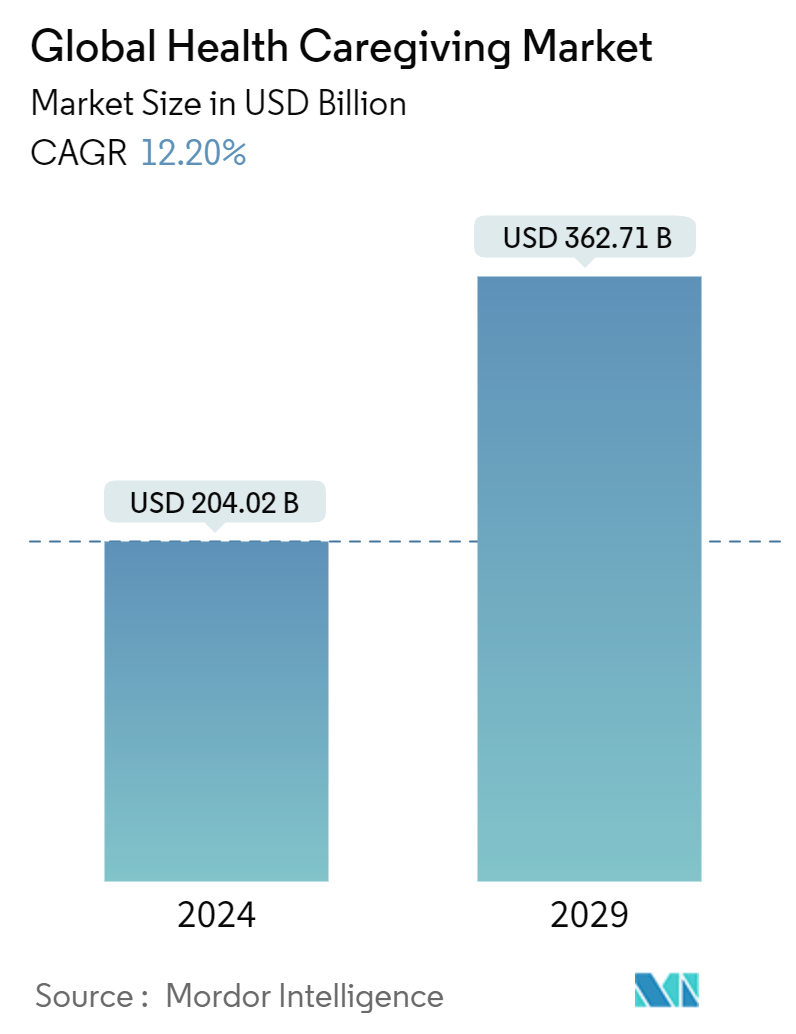
| Study Period | 2019 - 2029 |
| Market Size (2024) | USD 204.02 Billion |
| Market Size (2029) | USD 362.71 Billion |
| CAGR (2024 - 2029) | 12.20 % |
| Fastest Growing Market | Asia-Pacific |
| Largest Market | North America |
Major Players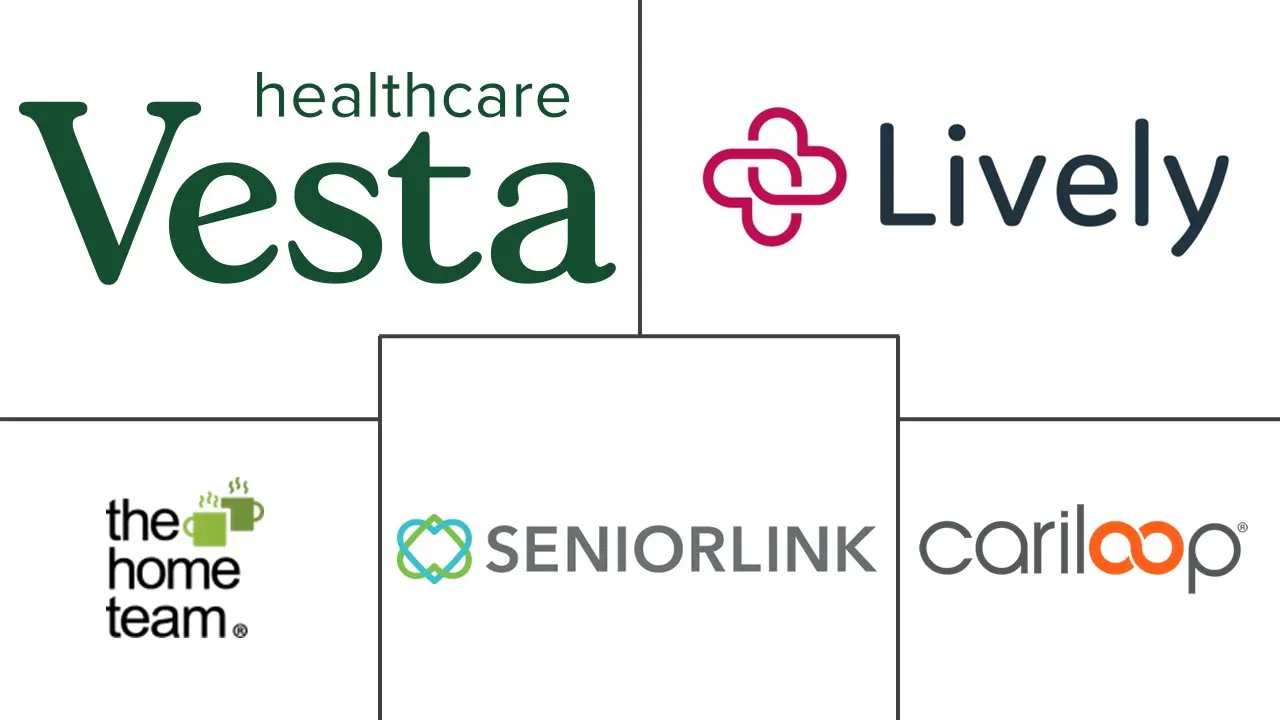
*Disclaimer: Major Players sorted in no particular order |
Need a report that reflects how COVID-19 has impacted this market and its growth?
Health Caregiving Market Analysis
The Global Health Caregiving Market size is estimated at USD 204.02 billion in 2024, and is expected to reach USD 362.71 billion by 2029, growing at a CAGR of 12.20% during the forecast period (2024-2029).
The health caregiving market was adversely affected by the pandemic. For instance, in November 2021, a report published by the Blue Cross and Blue Shield Association stated that the elevated rate of COVID-related deaths in long-term care facilities exposed inadequacies in the current system and would refocus attention on in-home care. Due to increased regulatory standards and demand, 30% of long-term care facilities could face bankruptcy in the coming years, forcing even more caregiving impact at home and onto unpaid family and friends. Data on the commercially insured population is supplemented with information on the Medicare fee-for-service population to capture caregiving demand among those 65 and older. The result of this analysis was an estimate that nearly 51 million Americans require some form of caregiving. However, there is wide geographic variation in this population, ranging from 11.1% to 20.7% of the total population at the state level. In addition, the market growth is stabilizing in the current scenario after COVID-19 as the worldwide restrictions have eased and various services have been resumed.
The market for health caregiving is being driven by the increase in disposable income, the prevalence of surgery, and technological developments in the field. For instance, according to the PETERSON-KFF Health System Tracker data published in February 2022, the United States' health care spending increased 9.7% to reach USD 4.1 trillion in 2020, a much faster rate than the 4.3% increase seen compared to the previous year. The acceleration in 2020 was due to a 36.0% increase in federal expenditures for health care that occurred largely in response to the COVID-19 pandemic. The private business share of health spending accounted for 16.7% of total health care spending, state and local governments accounted for 14.3%, and other private revenues accounted for 6.5%.
Moreover, in February 2022, Malta became the first country to introduce iSupport, the WHO online training for caregivers of people with dementia. The training that started in Malta is the result of a two-year effort by the Ministry for Senior Citizens and Active Aging, clinicians, academics, civil society organizations, and caregivers of people with dementia to adapt the original WHO version to the Maltese context.
As a result, all of the aforementioned factors are expected to drive market growth during the forecast period. However, the overall fragmented market weakens the service's adoption potential.
Health Caregiving Market Trends
Geriatric Population Segment is Expected to Hold a Significant Market Share Over the Forecast Period
The geriatric population is prone to diseases and other medical conditions due to low immunity. Hence, the geriatric population requires better care. Hence, the increasing geriatric population is expected to fuel demand for health caregiving facilities and increase market growth. According to the WHO data updated in October 2022, by 2030, one out of every six people will be 60 years of age or older. The number of people aged 60 and up is expected to rise from 1 billion in 2020 to 1.4 billion by 2050. By 2050, the global population of people aged 60 and above will reach 2.1 billion. Between 2020 and 2050, the number of people aged 80 and above is expected to triple, reaching 426 million.
According to the same source, while population aging-the shift in a country's population distribution towards older ages-began in high-income countries (for example, 30% of the population in Japan is already over 60 years old), it is now low- and middle-income countries that are experiencing the most change.Two-thirds of the world's population over 60 will live in low- and middle-income countries by 2050. As a result, this will increase the demand for healthcare, thereby boosting market growth. According to a United Nations World Ageing report, in 2020, there were around 12.499 million people aged 65 or over in the United Kingdom. This number is projected to double to 18.775 million in 2050. The population aged 65 or over in the country is expected to increase by 25.3% in 2050. There has been a shift in the leading chronic diseases over the last century, resulting in a significant increase in life expectancy. Noncommunicable diseases, primarily affecting adults and the elderly, pose the greatest threat to global health.
Hence, the growing geriatric population, increasing life expectancy, and associated diseases are projected to boost market growth.
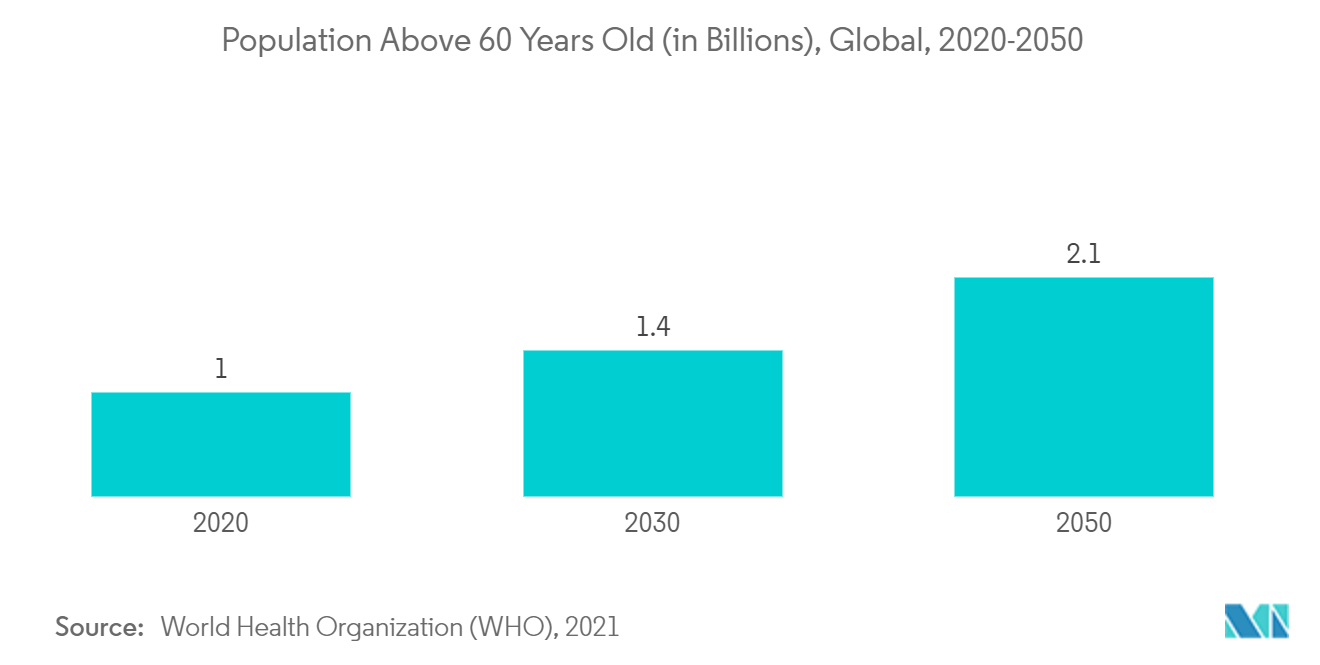
North America is Expected to Dominate the Market Over the Forecast Period
North America is expected to hold a major share of the market during the forecast period. North America has a big share of the global market because of how many people use advanced technology, how common chronic and lifestyle diseases are, how much money is spent on healthcare, how few doctors there are, and how many people want better healthcare services.
Factors such as funding, key partnerships, and investments are likely to increase the market's growth in the region. Initiatives by the public sector are one of the key factors for growth. For instance, in July 2021, the state of Indiana expanded its Structured Family Caregiving (SFC) program to allow legal guardians to receive much-needed support to continue caring for older adults in the comfort of their homes. Such initiatives would provide a suitable environment for the market to grow.
According to an estimate from the Canadian Imperial Bank of Commerce (CIBC) for 2021, the cost of caring for aging parents alone in this country is more than USD 33 billion. With an aging population and growing life expectancy, these issues are becoming more integral to the Canadian policy discussion each year. Investments and increased funding are key factors in the growth of the market. For instance, in August 2021, Honor Technology, Inc. acquired Home Instead for more than USD 2.1 billion to become the "default" provider of services for seniors in the United States.
Hence, due to the abovementioned factors, the market is likely to grow in the future.
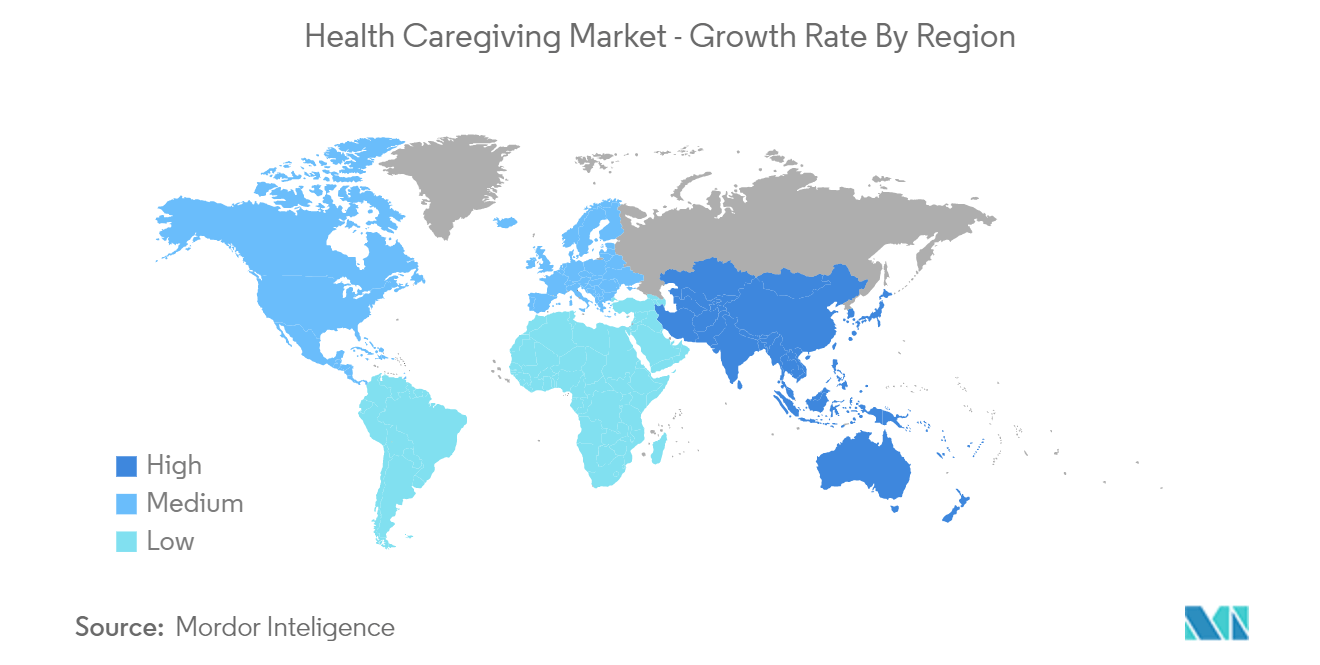
Health Caregiving Industry Overview
The Health Caregiving Market is partially fragmented and consists of several major players. The competitive landscape includes an analysis of a few international as well as local companies that hold large market shares and are well known. include Vesta Healthcare, Seniorlink, Inc., Lively, Cariloop, and HomeTeam.
Health Caregiving Market Leaders
-
Vesta Healthcare
-
Seniorlink, Inc.
-
Lively
-
Cariloop
-
HomeTeam
*Disclaimer: Major Players sorted in no particular order
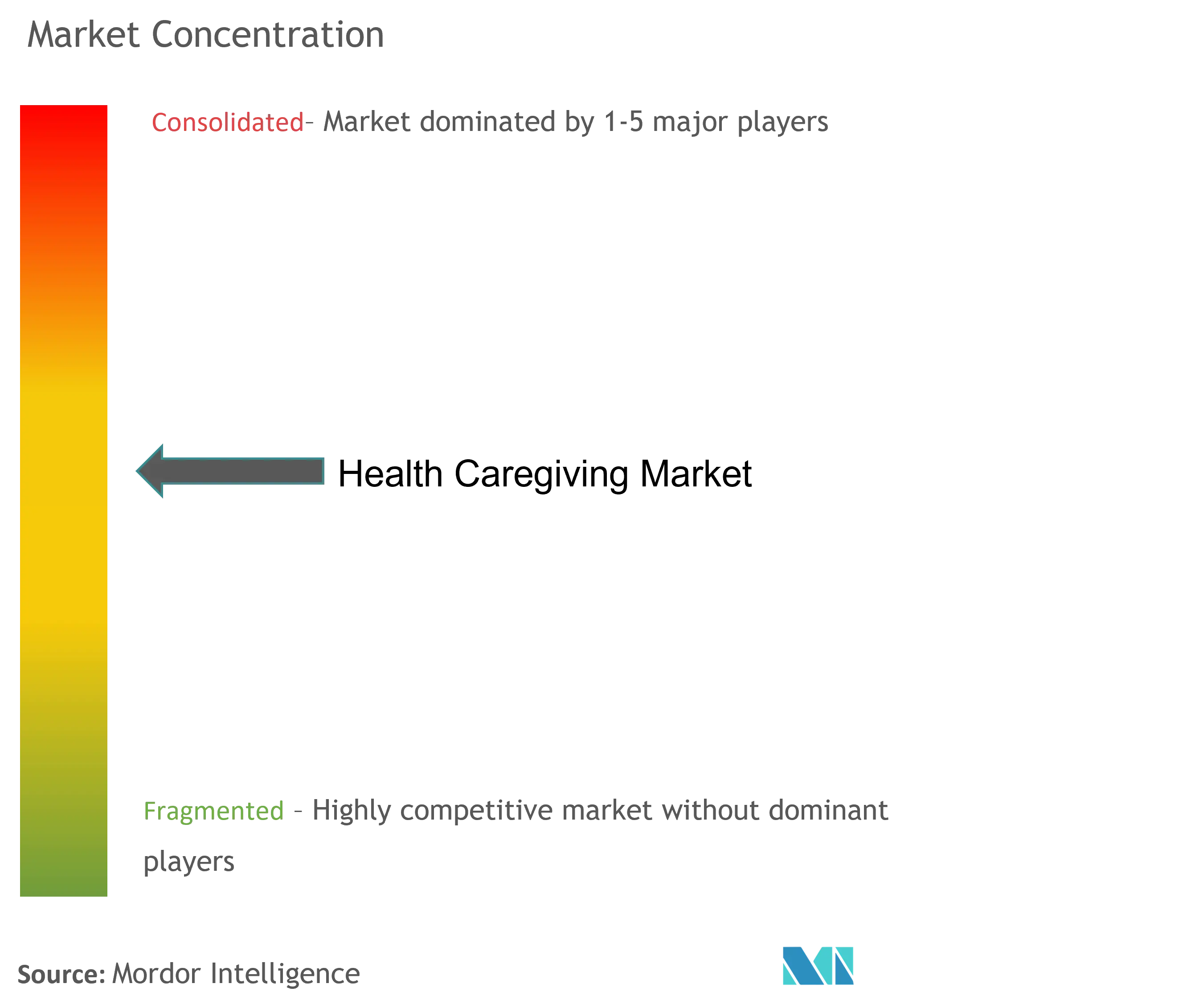
Health Caregiving Market News
- December 2022: Wellthy, Harvard Pilgrim Health Care, and Tufts Health Plan, both Point32 Health companies, are collaborating to help commercial members better manage their caregiving responsibilities.
- April 2022: Honor Technology, Inc. launched Honor Expert at the American Society on Aging Conference. Honor Expert is an online and mobile service that helps older people and their families with problems.
Health Caregiving Market Report - Table of Contents
1. INTRODUCTION
- 1.1 Study Assumptions and Market Definition
- 1.2 Scope of the Study
2. RESEARCH METHODOLOGY
3. EXECUTIVE SUMMARY
4. MARKET DYNAMICS
- 4.1 Market Overview
-
4.2 Market Drivers
- 4.2.1 Increasing Online Care Services
- 4.2.2 Growing Burden of Chronic Diseases
- 4.2.3 Increasing Geriatric Population
-
4.3 Market Restraints
- 4.3.1 Overall Fragmented Market Weakens Service Adoption Potential
-
4.4 Porter's Five Forces Analysis
- 4.4.1 Threat of New Entrants
- 4.4.2 Bargaining Power of Buyers/Consumers
- 4.4.3 Bargaining Power of Suppliers
- 4.4.4 Threat of Substitute Products
- 4.4.5 Intensity of Competitive Rivalry
5. MARKET SEGMENTATION (Market Size by Value - USD million)
-
5.1 By Care Type
- 5.1.1 Daily Essential Activities
- 5.1.2 Health and Safety Awareness
- 5.1.3 Social Well-Being
- 5.1.4 Others
-
5.2 By End User
- 5.2.1 Geriatric Population
- 5.2.2 Disabled Population
- 5.2.3 Others
-
5.3 Geography
- 5.3.1 North America
- 5.3.1.1 United States
- 5.3.1.2 Canada
- 5.3.1.3 Mexico
- 5.3.2 Europe
- 5.3.2.1 Germany
- 5.3.2.2 United Kingdom
- 5.3.2.3 France
- 5.3.2.4 Italy
- 5.3.2.5 Spain
- 5.3.2.6 Rest of Europe
- 5.3.3 Asia-Pacific
- 5.3.3.1 China
- 5.3.3.2 Japan
- 5.3.3.3 India
- 5.3.3.4 Australia
- 5.3.3.5 South Korea
- 5.3.3.6 Rest of Asia-Pacific
- 5.3.4 Middle-East and Africa
- 5.3.4.1 GCC
- 5.3.4.2 South Africa
- 5.3.4.3 Rest of Middle-East and Africa
- 5.3.5 South America
- 5.3.5.1 Brazil
- 5.3.5.2 Argentina
- 5.3.5.3 Rest of South America
6. COMPETITIVE LANDSCAPE
-
6.1 Company Profiles
- 6.1.1 AccentCare
- 6.1.2 Amedisys
- 6.1.3 Brookdale
- 6.1.4 Care.com, Inc.
- 6.1.5 Cariloop
- 6.1.6 HomeTeam
- 6.1.7 Honor Technology, Inc.
- 6.1.8 Knight Health Holdings, LLC
- 6.1.9 Lively
- 6.1.10 Room2Care
- 6.1.11 Seniorlink, Inc.
- 6.1.12 Vesta Healthcare
- *List Not Exhaustive
7. MARKET OPPORTUNITIES AND FUTURE TRENDS
** Subject To AvailablityHealth Caregiving Industry Segmentation
As per scope, health caregiving includes emotional support and help to manage a chronic disease or disability. Caregiving responsibilities can increase and change as the recipient's needs increase. The health caregiving market is segmented by care type (daily essential activities, health and safety awareness, social well-being, and others), end user (geriatric population, disabled population, and others), and geography (North America, Europe, Asia-Pacific, the Middle East and Africa, and South America). The market report also covers the estimated market sizes and trends for 17 countries across major global regions. The report offers a value (USD million) for the above segments.
| By Care Type | Daily Essential Activities | |
| Health and Safety Awareness | ||
| Social Well-Being | ||
| Others | ||
| By End User | Geriatric Population | |
| Disabled Population | ||
| Others | ||
| Geography | North America | United States |
| Canada | ||
| Mexico | ||
| Geography | Europe | Germany |
| United Kingdom | ||
| France | ||
| Italy | ||
| Spain | ||
| Rest of Europe | ||
| Geography | Asia-Pacific | China |
| Japan | ||
| India | ||
| Australia | ||
| South Korea | ||
| Rest of Asia-Pacific | ||
| Geography | Middle-East and Africa | GCC |
| South Africa | ||
| Rest of Middle-East and Africa | ||
| Geography | South America | Brazil |
| Argentina | ||
| Rest of South America |
Health Caregiving Market Research FAQs
How big is the Global Health Caregiving Market?
The Global Health Caregiving Market size is expected to reach USD 204.02 billion in 2024 and grow at a CAGR of 12.20% to reach USD 362.71 billion by 2029.
What is the current Global Health Caregiving Market size?
In 2024, the Global Health Caregiving Market size is expected to reach USD 204.02 billion.
Who are the key players in Global Health Caregiving Market?
Vesta Healthcare, Seniorlink, Inc., Lively, Cariloop and HomeTeam are the major companies operating in the Global Health Caregiving Market.
Which is the fastest growing region in Global Health Caregiving Market?
Asia-Pacific is estimated to grow at the highest CAGR over the forecast period (2024-2029).
Which region has the biggest share in Global Health Caregiving Market?
In 2024, the North America accounts for the largest market share in Global Health Caregiving Market.
What years does this Global Health Caregiving Market cover, and what was the market size in 2023?
In 2023, the Global Health Caregiving Market size was estimated at USD 179.13 billion. The report covers the Global Health Caregiving Market historical market size for years: 2019, 2020, 2021, 2022 and 2023. The report also forecasts the Global Health Caregiving Market size for years: 2024, 2025, 2026, 2027, 2028 and 2029.
What are the key growth opportunities for companies in the Health Caregiving Market?
The key growth opportunities for companies in the Health Caregiving Market are a) Remote patient monitoring b) Specialized caregiving services
What are the key growth opportunities for companies in the Health Caregiving Market?
The key growth opportunities for companies in the Health Caregiving Market are a) Remote patient monitoring b) Specialized caregiving services
Health Caregiving Industry Report
The global health caregiving market is witnessing significant growth driven by the increasing prevalence of chronic diseases, advancements in technology, and the growing trend of nuclear families. The market segmentation includes care type categories such as daily essential activities, health and safety awareness, social well-being, and others. End-user segments include the geriatric population, disabled population, and others. Technological innovations, such as user-friendly apps and online home delivery services, are anticipated to create positive disruptions in the caregiving industry.
Additionally, the increasing dependency on social media platforms for information sharing and service comparison among healthcare professionals is reshaping the market landscape. The market growth is poised to be robust in the coming years, fueled by the rising demand for comprehensive caregiving solutions and strategic developments by key players in the caregiving industry. The market overview highlights the importance of industry analysis and industry research in understanding the market trends and market forecast.
The market leaders are focusing on providing effective caregiving solutions to cater to the needs of the geriatric and disabled population. The market outlook suggests a positive trajectory for the industry, with market predictions indicating substantial market value. The industry size and industry statistics emphasize the significant market share held by key players, while the market review provides insights into the market segmentation and market data.
For more detailed insights, get a sample of this industry analysis as a free report PDF download. The report example includes comprehensive industry reports and industry information, offering valuable industry outlook and industry trends. Research companies are actively contributing to the market growth by providing essential market research and market analysis. The market forecast and market predictions further underscore the potential for continued market expansion and growth rate in the caregiving sector.

